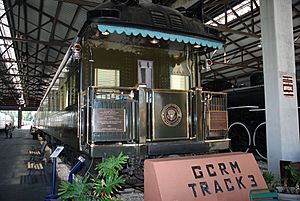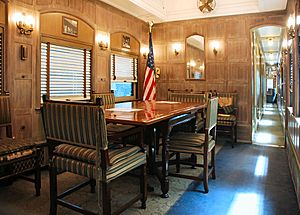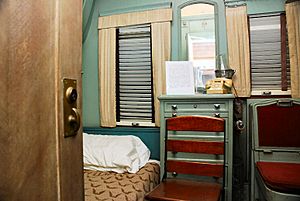Ferdinand Magellan (railcar) facts for kids
Quick facts for kids Ferdinand Magellan Pullman Car |
|
|---|---|

The Ferdinand Magellan at the Gold Coast Railway Museum
|
|

The Dining room
|
|
| Manufacturer | Pullman Company |
| Order no. | Lot 6246 |
| Constructed | 1929 |
| Refurbishment | 1942 |
| Diagram | Pullman Plan 3972D |
| Specifications | |
| Track gauge | 4 ft 8 1⁄2 in (1,435 mm) |
|
Ferdinand Magellan Railcar
|
|
| Location | Miami-Dade County, Florida, USA |
| Nearest city | Miami, Florida |
| NRHP reference No. | 77000401 |
| Significant dates | |
| Added to NRHP | February 4, 1985 |
| Designated NHL | February 4, 1985 |
The Ferdinand Magellan is a special train car named after the famous Portuguese explorer. It was also known as U.S. Car. No. 1. This car was originally a fancy private observation car built by the Pullman Company. From 1943 to 1958, it served as the official train car for the President of the United States.
Today, the Ferdinand Magellan is owned by the Gold Coast Railroad Museum in Miami-Dade County, Florida. They got the car in 1959. Because of its important history, the Ferdinand Magellan was recognized as a National Historic Landmark on February 4, 1985, by the United States Department of the Interior, National Park Service.
Contents
History of the Ferdinand Magellan Railcar
The Ferdinand Magellan was built in 1929 by the Pullman Company. It was one of six similar luxury cars, each named after a famous explorer. These cars included names like David Livingstone, Henry Stanley, Marco Polo, Robert Peary, Roald Amundsen, and, of course, Ferdinand Magellan.
When the United States joined World War II, President Franklin D. Roosevelt needed a safer way to travel. His Secret Service agents suggested he use a specially built and armored train car. The Ferdinand Magellan was chosen for this important job. The Pullman Company then rebuilt the car to make it very secure. This made the Ferdinand Magellan the first passenger train car built specifically for a President since Abraham Lincoln's special car in 1865. Another similar car, the Roald Amundsen, has also been saved and is listed as a historic place.
Special Features of the Presidential Car
When the Ferdinand Magellan was turned into United States Railcar No. 1, it got many upgrades. The original six bedrooms were changed to four. The dining room and observation lounge were made larger. Two of the bedrooms became a suite for the President and the First Lady. This suite had a full bathroom, even with a bathtub, connecting the two rooms.
The dining room was also used as a meeting room. It had a large, solid mahogany table that could seat eight people. The front part of the car had rooms for two stewards (people who served the President), a small kitchen, and storage areas.
Safety and Security Features
The car was made very safe with thick armor plate on its sides, top, bottom, and ends. The windows were replaced with very thick, bullet-resistant glass. Because the windows were sealed for safety, the car was air conditioned. This was done by blowing air over pipes that held melting ice.
Other cool features included:
- Strong, bank vault-style doors at the back entrance.
- Two escape hatches in case of an emergency.
- Outside loudspeakers for the President to give speeches.
- A telephone in every room that could connect to local phone lines.
- A special wheelchair elevator to help President Roosevelt get onto the car. This elevator was removed after he passed away in 1945.
All these changes made the Ferdinand Magellan much heavier. It became the heaviest passenger train car ever used in the United States. The car always traveled at the end of a special train. This train also included sleeping cars for staff, baggage cars, and a communications car run by the Army Signal Corps.
Presidential Journeys
President Roosevelt first used the Ferdinand Magellan for a trip to Miami, Florida, in 1943. From there, he took a flying boat to the Casablanca Conference. Over the next two years, he traveled about 50,000 miles (81,500 km) in the car. He used it for the last time on a trip to Warm Springs, Georgia, just two weeks before he died there.
Like other observation cars of its time, the Ferdinand Magellan had an open platform at the very back. This platform gave people a clear view in three directions. President Harry Truman famously used this platform for his "whistlestop" campaign speeches. During his campaign, the car traveled over 28,000 miles (46,284 km). Truman gave almost 350 speeches from the back platform. The famous photo of Truman holding the newspaper with the wrong "Dewey Defeats Truman" headline was taken on this very platform.
President Dwight D. Eisenhower did not use the Ferdinand Magellan very often. He traveled in it a few times to his farm in Gettysburg, Pennsylvania. He also visited his brother in University Park, Pennsylvania and once traveled to Ottawa to speak to the Parliament of Canada. The car was last officially used in 1954. That's when Mamie Eisenhower rode it to Groton, Connecticut, to christen (officially name) the first nuclear submarine, the Nautilus.
In 1958, the car was offered to the Smithsonian Institution, but they didn't take it. So, the Gold Coast Railroad Museum was able to get it instead.
Return to Service for President Reagan
In 1984, the Ferdinand Magellan made a brief comeback. It was loaned to President Ronald Reagan for his re-election campaign. On October 12, 1984, President Reagan gave a series of "whistlestop" speeches from the car's rear platform during a one-day trip in Ohio.
Moving the train from Florida to Ohio and getting it ready was a big effort. More than 100,000 people came to see President Reagan. At each stop, he remembered President Truman and said he would also make clear the differences between himself and his opponent. Campaign director Ed Rollins said, "It was super. The President loved it." This journey was the last time the Ferdinand Magellan was used for presidential travel.
Images for kids
See also
 In Spanish: Ferdinand Magellan Railcar para niños
In Spanish: Ferdinand Magellan Railcar para niños




